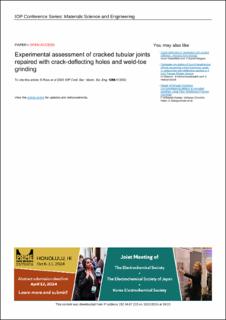| dc.contributor.author | Riise, Simen | |
| dc.contributor.author | Atteya, Mostafa Ahmed | |
| dc.contributor.author | Mikkelsen, Ove | |
| dc.contributor.author | Ersdal, Gerhard | |
| dc.date.accessioned | 2024-02-01T13:55:19Z | |
| dc.date.available | 2024-02-01T13:55:19Z | |
| dc.date.created | 2024-01-02T16:01:14Z | |
| dc.date.issued | 2023 | |
| dc.identifier.citation | Riise, S., Atteya, M.A., Mikkelsen, O., Ersdal, G. (2023) Experimental assessment of cracked tubular joints repaired with crack-deflecting holes and weld-toe grinding. IOP Conference Series: Materials Science and Engineering, 1294, 012032 | en_US |
| dc.identifier.issn | 1757-8981 | |
| dc.identifier.uri | https://hdl.handle.net/11250/3115095 | |
| dc.description.abstract | Tubular joints in offshore structures for energy production are exposed to cyclic loading and may experience fatigue cracking. Presently, the inspection method commonly used for such structures will primarily detect whether a member is flooded, which is an indication of through thickness cracks. As a result, repair methods suitable for repairing through thickness cracks that are cost-effective and quick to implement are needed. One such repair method could be crack arrest by hole drilling. However, the validity of such a repair method is at present not sufficiently proven. Hence, this paper presents the results of an experimental fatigue test of pre-cracked tubular joint repaired with crack-deflecting holes combined weld-toe grinding. One tubular double T joint was tested and underwent three-phases comprising of a pre-cracking phase, a repair phase and a post-repair testing phase. The through-thickness fatigue crack was achieved by subjecting the intact test joint to cyclic axial loading within the high-cycle fatigue domain. In the repair phase, crack-deflecting holes were drilled in front of each crack tip to arrest the crack ends. In addition, the weld-toe behind these holes were grinded to enhance the fatigue life of the repaired joint. The performances of the repaired test joint were then investigated in the last phase by subjecting it to further cyclic loading within the high cycles fatigue domain. In the test, the crack was successfully arrested in the crack-deflecting holes. Furthermore, the repair method indicated an apparent enhancement of the fatigue endurance of the cracked tubular joint when subjected to stress ranges within the high-cycle fatigue domain. | en_US |
| dc.language.iso | eng | en_US |
| dc.publisher | IOP Publishing | en_US |
| dc.rights | Navngivelse 4.0 Internasjonal | * |
| dc.rights.uri | http://creativecommons.org/licenses/by/4.0/deed.no | * |
| dc.subject | offshoreteknologi | en_US |
| dc.title | Experimental assessment of cracked tubular joints repaired with crack-deflecting holes and weld-toe grinding | en_US |
| dc.type | Peer reviewed | en_US |
| dc.type | Journal article | en_US |
| dc.description.version | publishedVersion | en_US |
| dc.subject.nsi | VDP::Teknologi: 500 | en_US |
| dc.source.volume | 1294 | en_US |
| dc.source.journal | IOP Conference Series: Materials Science and Engineering | en_US |
| dc.identifier.doi | 10.1088/1757-899X/1294/1/012032 | |
| dc.identifier.cristin | 2219249 | |
| dc.source.articlenumber | 012032 | en_US |
| cristin.ispublished | true | |
| cristin.fulltext | original | |
| cristin.qualitycode | 1 | |

